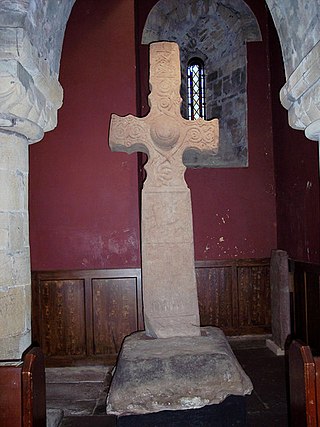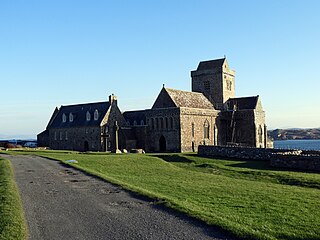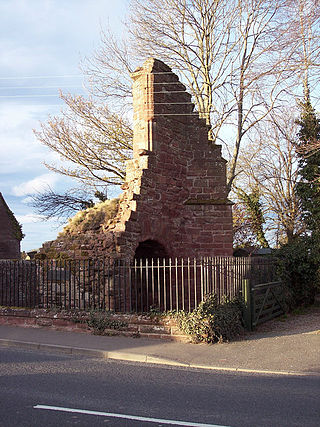
Causantín or Constantín mac Fergusa was king of the Picts, in modern Scotland, from 789 until 820. He was until the Victorian era sometimes counted as Constantine I of Scotland; the title is now generally given to Causantín mac Cináeda. He is credited with having founded the church at Dunkeld which later received relics of St Columba from Iona.

Iona Abbey is an abbey located on the island of Iona, just off the Isle of Mull on the West Coast of Scotland.
A coarb, from the Old Irish comarbae, meaning "heir" or "successor", was a distinctive office of the medieval Celtic Church among the Gaels of Ireland and Scotland. In this period coarb appears interchangeable with "erenach", denoting the episcopally nominated lay guardian of a parish church and headman of the family in hereditary occupation of church lands. The coarb, however, often had charge of a church which had held comparatively high rank in pre‐Norman Ireland, or one still possessed of relatively extensive termon lands.
The Abbot of Paisley was the head of the Cluniac monastic community of Paisley Abbey and its property. The monastery was founded as a priory at Renfrew in 1163, but moved to Paisley in 1169. It became an abbey in 1219. The founder was Walter fitz Alan, Seneschal (Steward) of Scotland. The line of abbots ended when it was turned into a secular lordship for Lord Claud Hamilton in 1587/1592. The following is a list of abbots and commendators:
Adomnán or Adamnán of Iona, also known as Eunan, was an abbot of Iona Abbey (r. 679–704), hagiographer, statesman, canon jurist, and saint. He was the author of the Life of Columba, probably written between 697 and 700. This biography is by far the most important surviving work written in early-medieval Scotland, and is a vital source for our knowledge of the Picts, and an insight into the life of Iona and the early-medieval Gaelic monk.

The Prior, then Abbot and then Commendator of Dunfermline was the head of the Benedictine monastic community of Dunfermline Abbey, Fife, Scotland. The abbey itself was founded in 1128 by King David I of Scotland, but was of earlier origin. King Máel Coluim mac Donnchada had founded a church there with the help of Benedictines from Canterbury. Monks had been sent there in the reign of Étgar mac Maíl Choluim and Anselm had sent a letter requesting that Étgar's brother and successor King Alaxandair mac Maíl Coluim protect these monks. By 1120, when Alaxandair sent a delegation to Canterbury to secure Eadmer for the bishopric of St Andrews, there is a Prior of the Dunfermline monks by the name of Peter leading the delegation. Control of the abbey was secularized in the 16th century and after the accession of James Stewart in 1500, the abbey was held by commendators. In the second half of the 16th century, the abbey's lands were being carved up into lordships and it was finally annexed to the crown in July, 1593.

Coupar Angus Abbey was a Cistercian monastery near Coupar Angus, in central Scotland, on the boundary between Angus and Gowrie.
The Prior of St Mary's Isle was the head of the Augustinian monastic community of St Mary's Isle Priory, in Kirkcudbrightshire, Galloway. The following is a list of priors and commendators:
William of Binning or William of Binin was a 13th-century Cistercian monk. His name indicates that he came from Binning, in Uphall parish, West Lothian, Scotland; otherwise, his background is obscure. He emerges on 29 November 1243 when he is styled "Prior of Newbattle" and elected to be Abbot of Coupar Angus. According to Alexander Myln's 16th century Vitae Dunkeldensis ecclesiae episcoporum, when William was at Newbattle Abbey he authored a vita of John the Scot, successively Bishop of Dunkeld and Bishop of St Andrews. The vita has failed to survive. William resigned his position as Abbot of Coupar Angus on 29 September 1258. He died at an unknown date afterwards.
Donald Campbell was a 16th-century Scottish noble and churchman. He was the son of Archibald Campbell, 2nd Earl of Argyll and Elizabeth Stewart, daughter of John Stewart, 1st Earl of Lennox. From 1522, he was a student of St Salvator's College, at the University of St Andrews. After graduation, he became a cleric in his home diocese, the diocese of Argyll.
Robert Crichton was a 16th-century Scottish Catholic cleric.
The Bishop of Meath is an episcopal title which takes its name after the ancient Kingdom of Meath. In the Roman Catholic Church it remains as a separate title, but in the Church of Ireland it has been united with another bishopric.
Odo Ydonc was a 13th-century Premonstratensian prelate. The first recorded appearance of Odo was when he witnessed a charter by Donnchadh, Earl of Carrick, on 21 July 1225. In this document he is already Abbot of Dercongal, incidentally the first Abbot of Dercongal to appear on record.

Geoffrey was a 12th-century Anglo-Norman Benedictine monk and abbot. Of Anglo-Norman origin, he became monastic head of the Benedictine priory at Canterbury, before moving to Scotland to be the first Abbot of Dunfermline. As abbot he presided over the construction of the new monastery building, the immigration of English monks and settlers, and the accumulation of enough wealth to make Dunfermline Abbey the richest Benedictine monastic house in the Kingdom of Scotland.
The Bishop of Emly was a separate episcopal title which took its name after the village of Emly in County Tipperary, Republic of Ireland. In both the Catholic Church and the Church of Ireland, it has been united with other sees.
Beccán mac Luigdech was a 7th-century Irish composer of Christian poetry and monk of Iona. He is known for having composed two vernacular poems, Fo réir Choluimb and Tiugraind Beccáin, which were written c. 640 in praise of St Columba, the founder of Iona. Along with Amra Choluim Cille, the fragment of the Life of St Cumméne (Cummian) and Adomnán's Life of Columba, the poems offer a contemporary glimpse of the monastic familia of Iona in the 7th century. Beccán has been identified with the Beccán solitarius who along with Ségéne, abbot of Iona, was addressed in a letter written by Cumméne in c. 632–33 concerning the Easter controversy. He may also be the Beccán of Rùm, whose death is recorded in the entry for 677 in the Annals of Ulster.
The Abbot of Emly was the head of the monastery in Emly, which is in modern-day County Tipperary, Ireland.
The Abbot of Lismore was the head of Lismore Abbey, which is in modern-day County Waterford, Ireland.
The battle of Cúl Dreimhne took place in the 6th century in the túath of Cairbre Drom Cliabh in northwest Ireland. The exact date for the battle varies from 555 AD to 561 AD. 560 AD is regarded as the most likely by modern scholars. The battle is notable for being possibly one of the earliest conflicts over copyright in the world.

Máel Brigte mac Tornáin, also known as Maelbrigte mac Durnan, was an Irish clergyman who served as abbot of Armagh from 883 and, in his role as Coarb of Colum Cille, as the Abbot of Iona, non-resident from 891, holding both positions until his death. He is likely responsible for commissioning and may have worked on the Mac Durnan Gospels, an illuminated manuscript now held in the Lambeth Palace Library in London.







